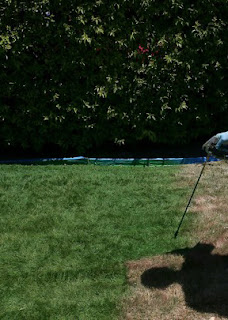Paeonia lactiflora
I pass a garden full of peonies on my way to the shops. Most of the year my eyes would be fixed on
the pavement, the road or phone depending on traffic conditions, but in these
few short weeks the beautiful display of large pink and cream flowers shout at
me from over their garden wall.
These particular plants are called Paeonia lactiflora ‘Bowl
of Beauty’ and fall into the category of herbaceous peony. These are the most well-known
type of peony. They are disease resistant perennial plants that enhance the
structure and beauty of any garden and produce some of the best cut flowers
available. They bloom during the transition from spring into summer, with each
individual cultivar blooming only around 7-10 days. The foliage of shining
green leaves remains throughout the summer, dies back to the ground in winter
and re-emerges early each spring.
Herbaceous peonies require very little care and live for
generations.
There are other less
known type of peonies.
We have the Tree Peonies, which are woody perennial shrubs.
Woodland Herbaceous Peonies that are worth noting
individually due to their preference for shade. Intersectional Peonies, also known
as Itoh which are a hybrid created by crossing a tree peony with an herbaceous
peony and are quite rare. There are also peonies that grow well in containers
called Patio peonies.
You can buy the plants now from garden centres and it’s a
good time to see the real flowers and if they appeal to you, alternatively you
can buy bare-rooted plants in autumn. They do need quite a bit of space to
flourish, enjoy full sun and mulch in spring.
They can be propagated by division too in autumn which also helps to
rejuvenate the parent plant.
Cuckoo spit
(spittlebugs)
Gardeners are being urged to report sightings of spittle on
their plants in a bid to stop the insects inside spreading a deadly disease
through the UK and Ireland.
 The disease is called Xylella fastidiosa bacteria, which
prevents water travelling from roots to leaves. It can cause symptoms including
leaf scorch, wilt, dieback and plant death. The disease is spread by insects
that feed on the xylem of plants. This includes froghoppers which live in the
spittle.
The disease is called Xylella fastidiosa bacteria, which
prevents water travelling from roots to leaves. It can cause symptoms including
leaf scorch, wilt, dieback and plant death. The disease is spread by insects
that feed on the xylem of plants. This includes froghoppers which live in the
spittle.
While the disease has not yet been spotted here, it has
already taken hold in France, Spain and Italy, where it has killed millions of
olive trees.
Cuckoo spit which surrounds the insect begins to appear in
late spring at a time when the familiar call of cuckoos can be heard, but
otherwise has no connection with the bird.
If Xylella is discovered, all host plants within 100 metres
would need to be destroyed. The RHS (Royal Horticultural Society) also say there
would also be an immediate restriction of movement for some plants within a
five kilometre radius, so it’s being taken pretty seriously.
More than 500 plants are at risk, including lavender, oleander,
rose, rosemary, chrysanthemum, dahlia, fuchsia, willow and flowering cherry.
Any sightings can be reported online at xylem feeding
insects.co.uk who will redirect you to the survey. The survey will help to gather
data to inform a response should Xylella reach the UK.
Spittlebugs are not a pest, so please don't remove them, but
they are an innocent carrier of Xylella.
Biology
This froth has no connection with cuckoos
It is secreted by the immature stages of sap-sucking insects
known as froghoppers, presumably as a means of protecting themselves against
predators
The adult insects are present during mid-late summer and
live openly on plants. They do not
produce cuckoo spit or cause any noticeable damage
Overwintering eggs are deposited in plant stems in late
summer.
Can be found in UK gardens, meadows, grasslands and
woodlands from April to late June
The most common species here is the meadow spittlebug
(Philaenus spumarius). Adults are 0.5cm long and vary in pattern and colour
from pale brown to black and can jump many times their body length
The red-and-black spittlebug hatches out on the roots of
plants, rather than in blobs of spittle on plant stems
There are ten species of spittlebug in the UK and Ireland and
the young - called nymphs - all produce whitish, frothy blobs of spittle on
leaves and branches.
Control
- Apart from producing the 'spit' these insects have little detrimental effect on plants.
- If considered unsightly, they can be wiped off by hand or dislodged with a jet of water from a garden hose.
- There is no need to use an insecticide against froghoppers.








